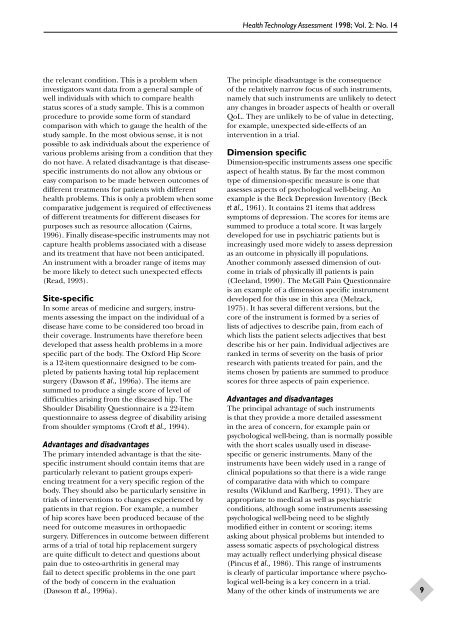Evaluating Patient-Based Outcome Measures - NIHR Health ...
Evaluating Patient-Based Outcome Measures - NIHR Health ...
Evaluating Patient-Based Outcome Measures - NIHR Health ...
Create successful ePaper yourself
Turn your PDF publications into a flip-book with our unique Google optimized e-Paper software.
the relevant condition. This is a problem when<br />
investigators want data from a general sample of<br />
well individuals with which to compare health<br />
status scores of a study sample. This is a common<br />
procedure to provide some form of standard<br />
comparison with which to gauge the health of the<br />
study sample. In the most obvious sense, it is not<br />
possible to ask individuals about the experience of<br />
various problems arising from a condition that they<br />
do not have. A related disadvantage is that diseasespecific<br />
instruments do not allow any obvious or<br />
easy comparison to be made between outcomes of<br />
different treatments for patients with different<br />
health problems. This is only a problem when some<br />
comparative judgement is required of effectiveness<br />
of different treatments for different diseases for<br />
purposes such as resource allocation (Cairns,<br />
1996). Finally disease-specific instruments may not<br />
capture health problems associated with a disease<br />
and its treatment that have not been anticipated.<br />
An instrument with a broader range of items may<br />
be more likely to detect such unexpected effects<br />
(Read, 1993).<br />
Site-specific<br />
In some areas of medicine and surgery, instruments<br />
assessing the impact on the individual of a<br />
disease have come to be considered too broad in<br />
their coverage. Instruments have therefore been<br />
developed that assess health problems in a more<br />
specific part of the body. The Oxford Hip Score<br />
is a 12-item questionnaire designed to be completed<br />
by patients having total hip replacement<br />
surgery (Dawson et al., 1996a). The items are<br />
summed to produce a single score of level of<br />
difficulties arising from the diseased hip. The<br />
Shoulder Disability Questionnaire is a 22-item<br />
questionnaire to assess degree of disability arising<br />
from shoulder symptoms (Croft et al., 1994).<br />
Advantages and disadvantages<br />
The primary intended advantage is that the sitespecific<br />
instrument should contain items that are<br />
particularly relevant to patient groups experiencing<br />
treatment for a very specific region of the<br />
body. They should also be particularly sensitive in<br />
trials of interventions to changes experienced by<br />
patients in that region. For example, a number<br />
of hip scores have been produced because of the<br />
need for outcome measures in orthopaedic<br />
surgery. Differences in outcome between different<br />
arms of a trial of total hip replacement surgery<br />
are quite difficult to detect and questions about<br />
pain due to osteo-arthritis in general may<br />
fail to detect specific problems in the one part<br />
of the body of concern in the evaluation<br />
(Dawson et al., 1996a).<br />
<strong>Health</strong> Technology Assessment 1998; Vol. 2: No. 14<br />
The principle disadvantage is the consequence<br />
of the relatively narrow focus of such instruments,<br />
namely that such instruments are unlikely to detect<br />
any changes in broader aspects of health or overall<br />
QoL. They are unlikely to be of value in detecting,<br />
for example, unexpected side-effects of an<br />
intervention in a trial.<br />
Dimension specific<br />
Dimension-specific instruments assess one specific<br />
aspect of health status. By far the most common<br />
type of dimension-specific measure is one that<br />
assesses aspects of psychological well-being. An<br />
example is the Beck Depression Inventory (Beck<br />
et al., 1961). It contains 21 items that address<br />
symptoms of depression. The scores for items are<br />
summed to produce a total score. It was largely<br />
developed for use in psychiatric patients but is<br />
increasingly used more widely to assess depression<br />
as an outcome in physically ill populations.<br />
Another commonly assessed dimension of outcome<br />
in trials of physically ill patients is pain<br />
(Cleeland, 1990). The McGill Pain Questionnaire<br />
is an example of a dimension specific instrument<br />
developed for this use in this area (Melzack,<br />
1975). It has several different versions, but the<br />
core of the instrument is formed by a series of<br />
lists of adjectives to describe pain, from each of<br />
which lists the patient selects adjectives that best<br />
describe his or her pain. Individual adjectives are<br />
ranked in terms of severity on the basis of prior<br />
research with patients treated for pain, and the<br />
items chosen by patients are summed to produce<br />
scores for three aspects of pain experience.<br />
Advantages and disadvantages<br />
The principal advantage of such instruments<br />
is that they provide a more detailed assessment<br />
in the area of concern, for example pain or<br />
psychological well-being, than is normally possible<br />
with the short scales usually used in diseasespecific<br />
or generic instruments. Many of the<br />
instruments have been widely used in a range of<br />
clinical populations so that there is a wide range<br />
of comparative data with which to compare<br />
results (Wiklund and Karlberg, 1991). They are<br />
appropriate to medical as well as psychiatric<br />
conditions, although some instruments assessing<br />
psychological well-being need to be slightly<br />
modified either in content or scoring; items<br />
asking about physical problems but intended to<br />
assess somatic aspects of psychological distress<br />
may actually reflect underlying physical disease<br />
(Pincus et al., 1986). This range of instruments<br />
is clearly of particular importance where psychological<br />
well-being is a key concern in a trial.<br />
Many of the other kinds of instruments we are<br />
9
















